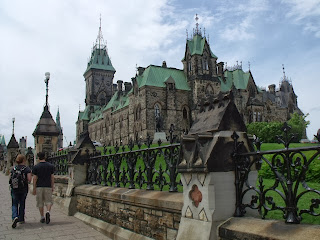 |
| Dowling The last flats before the Cambrian Shield |
The name
John Francis Dowling
- son of Irish immigrants
- born in 1851 at Lanark County, Canada West
- married James Bonfield's daughter Elizabeth
- became a Liberal MP 1883-86 and 1890-94 - same position as James Bonfield had in Renfrew South from 1875 - 83
John Egan was 19 years old in 1830 when he came to Aylmer, Lower Canada. He came there to learn the lumber trade in the settlements that were rising along old Algonquin First Nations territory. Ottawa didn't exist then. Bytown was just another settlement like Aylmer in the surrounding valley. Bytown would become Ottawa. Aylmer itself had been named after a British Governor of Canada at about the same time Egan came to Canada.
Likely, long before the Europeans came along, the Ottawa Nation, keepers of the trades according to the ancient Council of three fires treaty, came up this river many times to trade with the Algonquians. The traders river became the Ottawa river and Bytown became Ottawa. Aylmer and Hull were just suburbs of Ottawa.
Much of the commercial lumber industry rising in the Ottawa Valley in the early 1800's was the work of early American business men from Massachusetts. One of them was Philemon Wright.
 |
| Typical small sawmill - 1954 Somewhere between Lake Nippising and Larchwood - Dowling |
The north had opened up and the same traders came on the railroad to work the economy of the north.
In Chelmsford and Larchwood, these merchants and industrialists, were now in Ojibwa territory. However even before the Europeans came along the Ojibwa were not always alone in these vast white pine forests spotted with dozens of lakes. The Ojibwa would have been visited many times by the Cree to the north and the Algonquians of the south. Most of those visits would have been friendly and meant as ways of making life better by bonding through trade.
Some of the Algonquians and the Cree stayed. Most of the European immigrants also stayed and kept on trading whatever they could turn over to make a buck.
It is the way Dowling, aka Larchwood, aka Rheaume's Flats came to be. At first it was a lumber village. Then it was a mining camp with a trading post and a post office likely situated in the railroad station where the old postmaster or factor could send morse codes over the telegraph lines to partners of partners scattered all over the continent and all over the world.
But that is just imagination at work. The truth is beyond me.
There were a few pioneering days sawmills in Dowling. One of them was run by the Thompson's. The other Larchwood sawmill was run by the Wilson's. There were also a few of them in Chelmsford. The Chew's and the Coyne's were the sawmill operators there.
Most of these people were from the Midland and Prescott area where the competition for control of the lumber industry was fierce and where another Gordon was at one time running for his life away from Drummond Island and towards Penetanguishene, aka Gordon's Point.
So who were the Thompson's and the Wilson's ?

No comments:
Post a Comment